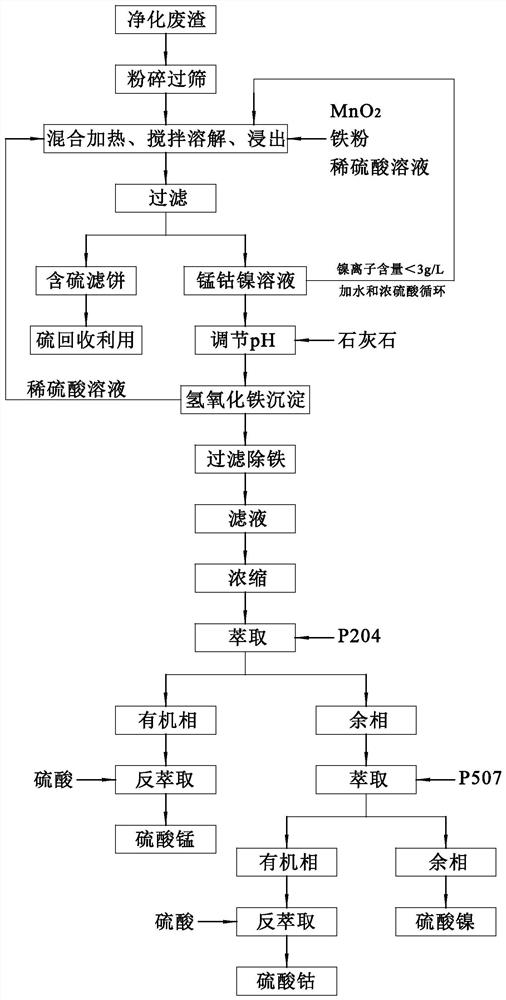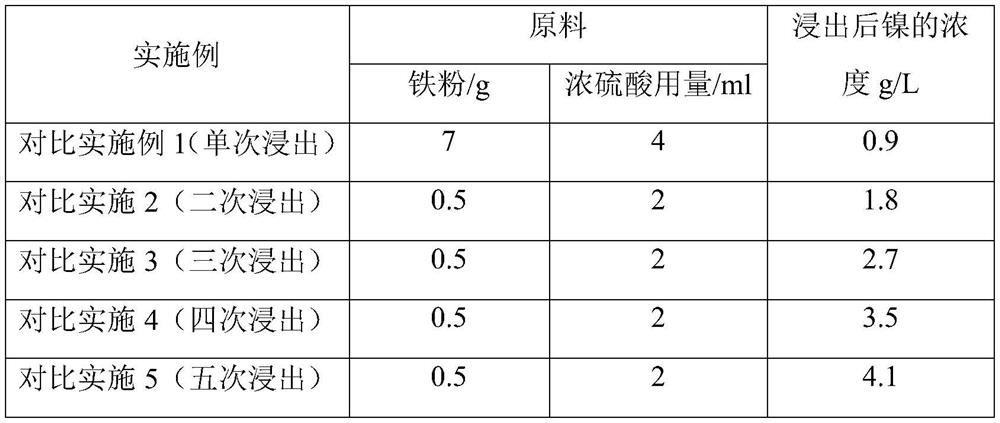A method for leaching, recovering and separating nickel from manganese-sulfur purification waste residue
A waste slag and leaching technology, which is applied in the direction of improving process efficiency, can solve the problems of low metal recovery rate and large consumption, and achieve the effects of improving leaching efficiency, avoiding pollution, and simple and easy process
- Summary
- Abstract
- Description
- Claims
- Application Information
AI Technical Summary
Problems solved by technology
Method used
Image
Examples
Embodiment 1
[0055] After crushing 10g of manganese-sulfur purification waste residue, pass through a 40-mesh sieve, and add 5g of MnO to the manganese-sulfur purification waste residue. 2 and 7g of iron powder, add 80mL of 0.5mol / L sulfuric acid solution, heat to 80°C, and stir on a 100r / min stirrer, after leaching for 30min, filter the leaching solution to obtain the leaching solution and adjust pH=4 with limestone to remove iron, filter the solution, and The solution was concentrated to 20 mL. Dilute 20mL P204 with 20mL sulfonated kerosene to prepare the extractant, then saponify with sodium hydroxide, the saponification rate is 10%, then add the extractant to the concentrated solution, stir on a 100r / min magnetic stirrer for 10min, then transfer the extract to Enter the separatory funnel to carry out phase separation, and the obtained organic phase is back-extracted with 1mol / L sulfuric acid to recover and separate manganese sulfate, and the recovery rate of manganese is measured to be...
Embodiment 2
[0057] After pulverizing 10g of manganese-sulfur purification waste residue, pass through a 40-mesh sieve, add 7gMnO to the manganese-sulfur purification waste residue in sequence 2 and 7g of iron powder, add 80mL of 0.5mol / L sulfuric acid solution, heat to 85°C, stir on a 100r / min stirrer, and after leaching for 30min, filter the leaching solution to obtain the leaching solution and use limestone to adjust pH=4 to remove iron, filter the solution, and The solution was concentrated to 20 mL. Dilute 30mL LP204 with 15mL sulfonated kerosene to prepare the extractant, then saponify with sodium hydroxide, the saponification rate is 60%, then add the extractant to the concentrated solution, stir on a 100r / min magnetic stirrer for 10min, then transfer the extract to Put it into a separatory funnel for phase separation, and the obtained organic phase is back-extracted with 1mol / L sulfuric acid to recover and separate manganese sulfate, and the recovery rate of manganese is measured t...
Embodiment 3
[0059] After pulverizing 10g of manganese-sulfur purification waste residue, pass through a 40-mesh sieve, add 9g of MnO to the manganese-sulfur purification waste residue in sequence 2 and 7g of iron powder, add 80mL of 0.5mol / L sulfuric acid solution, heat to 90°C, stir on a 100r / min stirrer, after leaching for 30min, filter the leaching solution to obtain the leaching solution and adjust pH=4 with limestone to remove iron, filter the solution, and The solution was concentrated to 20 mL. Dilute 45mL P204 with 15mL sulfonated kerosene to prepare the extractant, then saponify with sodium hydroxide, the saponification rate is 40%, then add the extractant to the concentrated solution, stir on a 100r / min magnetic stirrer for 10min, then transfer the extract to Put it into a separatory funnel for phase separation, and the obtained organic phase is back-extracted with 1mol / L sulfuric acid to recover and separate manganese sulfate, and the recovery rate of manganese is measured to b...
PUM
| Property | Measurement | Unit |
|---|---|---|
| recovery rate | aaaaa | aaaaa |
| recovery rate | aaaaa | aaaaa |
| recovery rate | aaaaa | aaaaa |
Abstract
Description
Claims
Application Information
 Login to View More
Login to View More - R&D
- Intellectual Property
- Life Sciences
- Materials
- Tech Scout
- Unparalleled Data Quality
- Higher Quality Content
- 60% Fewer Hallucinations
Browse by: Latest US Patents, China's latest patents, Technical Efficacy Thesaurus, Application Domain, Technology Topic, Popular Technical Reports.
© 2025 PatSnap. All rights reserved.Legal|Privacy policy|Modern Slavery Act Transparency Statement|Sitemap|About US| Contact US: help@patsnap.com


